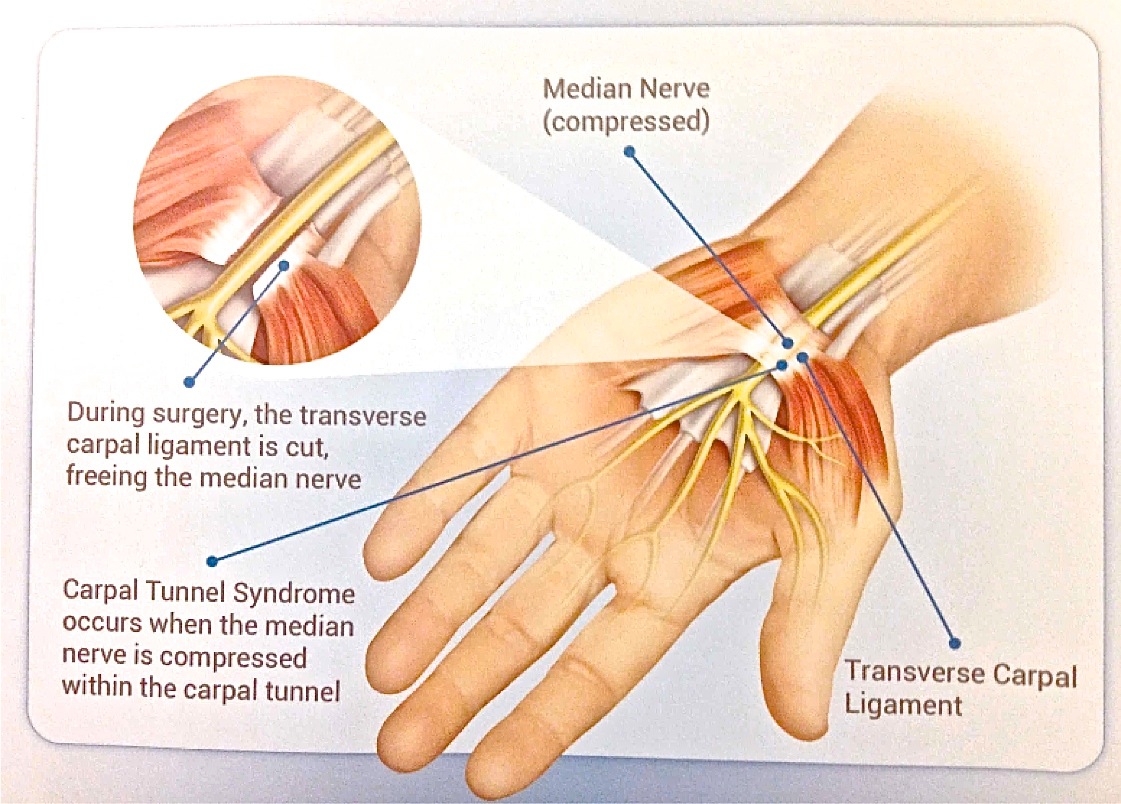
by
Carl Butterfield, M.D., and Steven Reid, M.D.
Introduction:
This syndrome involves the entrapment of the median nerve at the level of the wrist and palm, and is the most common compression syndrome occurring in the hand. The symptoms are caused by compression of the median nerve where it passes through a tunnel behind the transverse carpal ligament. Causes of carpal tunnel syndrome vary in origin from: l. Changes within the structures that make up the carpal tunnel (ex: thickening of the transverse carpal ligament, 2. Hormone imbalances that can lead to body fluid retention which closes the carpal tunnel (ex: pregnancy), or 3. Other underlying diseases (ex: diabetes, gout, etc.) This syndrome is more frequently found in women than men and is particularly bothersome at night. In about one-half of the population there are variations in the symptoms due to anatomical variations in the median nerve and.or its branches (ex: the branch that goes to the base of the thumb). Over 90% of patients with carpal tunnel syndrome have either changes in feeling and/or strength of the affected hand.
Symptoms:
Frequently, patients experience numbness, tingling and burning sensations in the lateral part of the palm of the hand. Symptoms may even radiate back up the arm to the shoulder. The symptoms occur, and often wake the patient during sleeping hours due to the tendency of people to sleep with their wrists flexed inward. With time, many patients experience weakness of the affected hand and decrease or loss of feeling in the palm and fingers. It is important to note that symptoms can vary from time to time and from person to person. After treatment (both surgical and non-surgical) some symptoms may take longer or not resolve completely, depending on the underlying cause, and the condition of the median nerve or whether or not the compression led to permanent nerve damage.
Diagnosis:
Diagnosis of carpal tunnel syndrome may be made by a combination of physical examination and history of the symptoms, and by electrical studies. (Electromyography (EMG), and nerve conduction studies). These studies usually reveal slowing and decrease in the transmission of nerve messages across the region where the nerve is compressed, resulting in sensory or feeling changes and muscle weakness.
Conservative Treatment:
The treatment plan is designed
to relieve the symptoms, and to prevent permanent nerve damage as much
as possible. Initially, conservative treatment is used to try to avoid
the need for surgery. This may involve the use of "cock-up" splints on
the wrists at night to prevent the compressing of the nerve by
preventing the wrists from being flexed during sleep. Other
non-surgical treatments may involve injection of steroid and/or
anesthetic agents, and, the treatment of any underlying cause (ex:
diabetes, gout, obesity, etc.). If conservative treatment measures do
not lead to satisfactory results, or if the median nerve is compressed
and in danger of permanent damage, then surgical treatment is
indicated.
Surgical Treatments:
The surgical treatment is
called a carpal tunnel release or median nerve neuroplasty. It
involves enlarging the carpal tunnel by opening the transverse carpal
ligament. The two most common operations both accomplish this
goal. The open, or conventional procedure, involves a deeper
incision in the palm to access the transverse carpal ligament from the
outside. The endoscopic procedure involves a shallower incision
at the wrist to access the transverse carpal ligament from the
inside. Anesthesia can be given locally at the incision site
accompanied by the use of a tranquilizer, or the procedure may be
performed under general anesthesia.
The surgical treatment usually takes about one hour and is done as an outpatient procedure. Actual operating surgical time (skin incision to final suture) usually takes about 10 minutes for the open operation, and about 25 min for the endoscopic operation.
Both the open and the endoscopic procedures have proven track records for safety and effectiveness. Most patients experience less soreness and a quicker recovery after the endoscopic procedure than with the open procedure.
Possible risks associated with a carpal tunnel release:
As with any surgical procedure, there are always possible risks though the risks may be very low, these risks need to be known and considered. They include, infection, bleeding, loss of life, paralysis, weakness, numbness, nonrelief, recurrence, pain, poor wound healing and other serious complications.
Desired benefits to a carpal tunnel release:
The main goal of a carpal tunnel release is to open the carpal tunnel so as to decompress the median nerve, and to provide relief of the problematic symptoms with improvement in strength and sensation. Greater than 90% of patients that undergo carpal tunnel release have satisfactory results.
Recommendations for patients after a carpal tunnel release:
In the first week or two after a carpal tunnel release, it is important to keep the incision clean and dry to prevent complications (such as infection) and to avoid pressure on the hand to prevent opening of the incision. Approximately one week after surgery the sutures will be removed. After the sutures have been removed, it is recommended that the incision site be rubbed with vitamin E oil or cocoa butter approximately three times a day to keep the incision area softened to facilitate healing and to prevent the skin from cracking.
Pain Management:
Patients will be prescribed pain medication after a carpal tunnel release to help relieve pain caused by having surgery. It is important to take these medications only as prescribed. Over use of pain medication is to be avoided to prevent the decrease in their ability to control pain and to prevent dependence on these medications.
Return to Patient Educational Materials Page